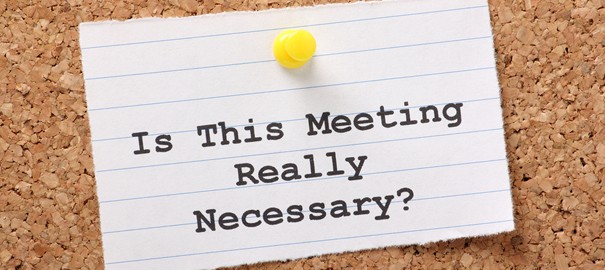The majority of meetings are lame. They suck the time, energy, and productivity right out of you and your team. Plus, too many ministries have way too many meetings to begin with. Realistically, we are throwing personnel money out the window at the majority of our meetings. Every meeting that takes place during a workweek is lost productivity from each member of the team that needs to show up to each meeting.
So, let’s say that you have ten people at an hour-long meeting. You’re not just losing one hour of potentially productive work. You’re actually losing out on at least ten total hours within the span of sixty minutes (10 x 1 = 10). This happens all the time in unproductive, non-action producing meetings.
Typically, the more meetings that take place and the more employees that need to attend each of those meetings, the less productive work is taking place within your ministry. I believe every team, organization, and ministry could benefit greatly from a serious audit of all of the meetings that take place each week.
The challenge, though, is that our teams DO need to meet regularly in order to achieve alignment. Yes, meetings are a necessary evil, but most teams do a poor job of organizing and executing their meetings. Here are some thoughts on executing better meetings in order to ultimately produce a more productive staff team.
Seven Suggestions on Making Meetings Better
1. Consider holding only afternoon meetings.
I would venture an educated guess that most organizations hold the majority of their meetings in the morning. I believe this is a bad move, and here’s why. The conventional wisdom on morning meetings has been to get them out of the way as early as possible and get the team in alignment for the rest of the day. The problem with this approach is that the morning hours are normally the most productive time for people. And, if you normally do meetings first thing in the morning, then you are potentially draining energy from your employees that will impact them the rest of the day. Since afternoon hours are traditionally less productive time for employees, I believe it would be a wise move to put the majority of meetings in the afternoon. Focus your team’s best individual work hours when they’re more likely to be at their best, 8:00 am-12:00 pm.
2. Create a meeting agenda for each meeting.
And, don’t only create a meeting agenda, but also email your team a couple of days in advance, asking them to add items to the agenda prior to the meeting. Lay down a rule that they can’t add agenda items inside the meeting. This should assist your team in avoiding “rabbit chasing,” as well as help you end the meeting on time.
3. Appoint a leader in charge of the meeting.
There should always be a leader who is clearly in charge of the meeting. The leader should understand that his role is to keep the meeting moving forward in the most efficient manner possible, while still achieving the necessary objectives.
4. Announce a distraction free zone.
The leader should do his best to ask team members to refrain from incoming calls, text messages, emails, and web surfing, unless they are necessary to achieve the objective of the meeting. These activities simply take the team off focus and make the meeting longer.
5. Start and end on time.
Have clear times for starting and ending the meeting (i.e. 1:00-2:00 pm). The leader of the meeting should do everything in his power to start and end on time, even if the team can’t make it all the way through the agenda. Any items missed can get moved to the next meeting’s agenda.
6. Create an action items list.
While moving through the meeting agenda, action items will most likely occur that need to be accomplished. The team leader or an administrative assistant should be tracking these action items and listing them at the end of their meeting notes.
7. Delegate tasks within the meeting.
On the listing of action items within the meeting notes, there should be a clear delegation of who has been assigned each action item, as well as an expected date of completion. This will help the team stay focused and productive long-term.











